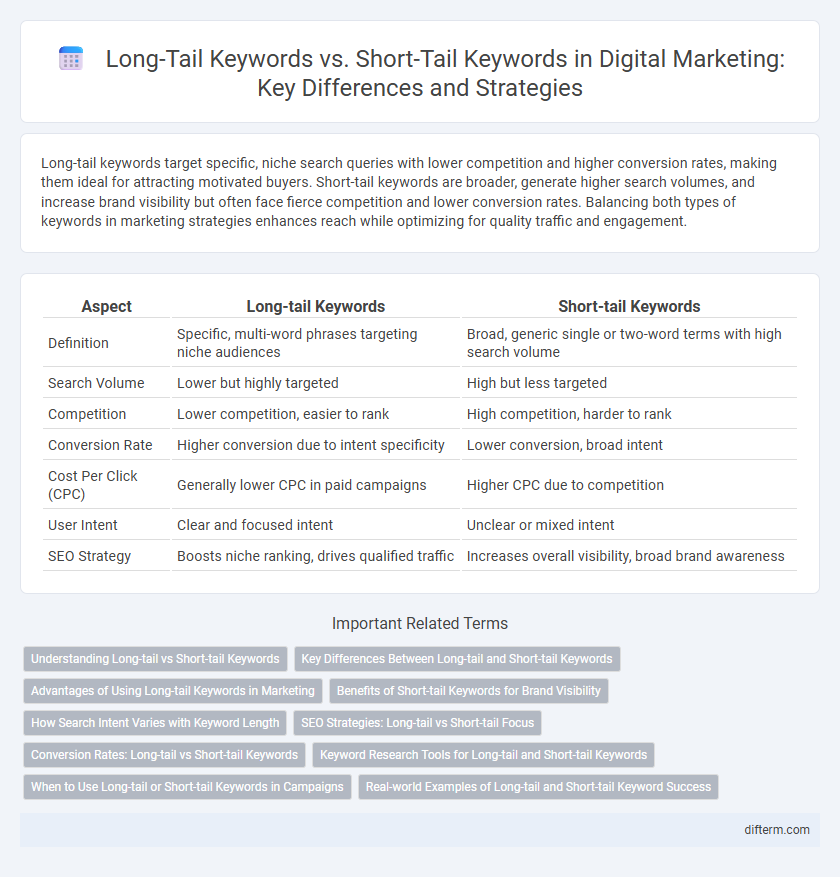Long-tail keywords target specific, niche search queries with lower competition and higher conversion rates, making them ideal for attracting motivated buyers. Short-tail keywords are broader, generate higher search volumes, and increase brand visibility but often face fierce competition and lower conversion rates. Balancing both types of keywords in marketing strategies enhances reach while optimizing for quality traffic and engagement.
Table of Comparison
| Aspect | Long-tail Keywords | Short-tail Keywords |
|---|---|---|
| Definition | Specific, multi-word phrases targeting niche audiences | Broad, generic single or two-word terms with high search volume |
| Search Volume | Lower but highly targeted | High but less targeted |
| Competition | Lower competition, easier to rank | High competition, harder to rank |
| Conversion Rate | Higher conversion due to intent specificity | Lower conversion, broad intent |
| Cost Per Click (CPC) | Generally lower CPC in paid campaigns | Higher CPC due to competition |
| User Intent | Clear and focused intent | Unclear or mixed intent |
| SEO Strategy | Boosts niche ranking, drives qualified traffic | Increases overall visibility, broad brand awareness |
Understanding Long-tail vs Short-tail Keywords
Long-tail keywords consist of longer, more specific phrases that attract niche audiences with higher conversion potential, whereas short-tail keywords are broader, higher-volume terms that generate more traffic but often have higher competition. Effective marketing strategies leverage long-tail keywords to target intent-driven searches, improving ad relevance and lowering cost-per-click (CPC). Understanding the balance between these keyword types allows marketers to optimize SEO and PPC campaigns for both visibility and engagement.
Key Differences Between Long-tail and Short-tail Keywords
Long-tail keywords consist of three or more words, targeting niche audiences with specific search intent, while short-tail keywords are broader and usually one to two words with higher search volume but more competition. Long-tail keywords tend to have lower cost-per-click (CPC) and higher conversion rates due to their specificity, whereas short-tail keywords drive significant traffic but often generate lower conversion rates. Marketers prioritize long-tail keywords for better ROI in content marketing and PPC campaigns, while short-tail keywords are essential for brand awareness and capturing wide-reaching searches.
Advantages of Using Long-tail Keywords in Marketing
Long-tail keywords drive highly targeted traffic by capturing specific search intents, leading to higher conversion rates and lower competition costs compared to short-tail keywords. These keywords enhance SEO effectiveness by improving content relevance and increasing the chances of ranking on niche search queries. Marketers benefit from long-tail keywords through better audience segmentation and more efficient ad spend, optimizing both organic and paid campaigns.
Benefits of Short-tail Keywords for Brand Visibility
Short-tail keywords enhance brand visibility by capturing high search volume and attracting a broad audience, increasing overall reach. They are essential for creating brand awareness quickly, as these general terms are frequently searched and connected to popular categories. Leveraging short-tail keywords boosts website traffic and improves search engine ranking for competitive brand-related searches.
How Search Intent Varies with Keyword Length
Long-tail keywords typically target highly specific search intent, attracting users looking for detailed information or niche products, which often results in higher conversion rates. Short-tail keywords capture broader search intent, generating higher traffic volumes but with more generalized user queries and lower conversion specificity. Understanding the variation in search intent between long-tail and short-tail keywords enables marketers to tailor content strategies for better audience targeting and improved SEO performance.
SEO Strategies: Long-tail vs Short-tail Focus
Long-tail keywords generate higher conversion rates by targeting specific search intent, making them essential for niche marketing and driving qualified traffic. Short-tail keywords attract higher search volume, increasing brand visibility but often face intense competition and lower conversion rates. Integrating both long-tail and short-tail keywords optimizes SEO strategies by balancing traffic acquisition with quality audience engagement.
Conversion Rates: Long-tail vs Short-tail Keywords
Long-tail keywords exhibit higher conversion rates due to their specificity, attracting more qualified traffic and better aligning with user intent. Short-tail keywords generate greater search volume but often result in lower conversion rates because of their broader competition and less precise targeting. Businesses prioritizing conversion efficiency should focus on long-tail keywords to maximize ROI and engage a more targeted audience.
Keyword Research Tools for Long-tail and Short-tail Keywords
Keyword research tools like Ahrefs, SEMrush, and Google Keyword Planner provide valuable data for both long-tail and short-tail keywords, enabling marketers to analyze search volume, competition, and user intent effectively. Long-tail keywords generated by these tools typically exhibit lower competition and higher conversion rates, making them ideal for niche targeting and content specificity. Short-tail keywords, although higher in search volume, demand strategic optimization due to fierce competition, and keyword research tools help identify opportunities for ranking and ad targeting within this segment.
When to Use Long-tail or Short-tail Keywords in Campaigns
Long-tail keywords are ideal for targeting niche audiences and driving highly qualified traffic with lower competition, making them perfect for campaigns focused on conversion and specific customer intents. Short-tail keywords generate higher search volume and brand visibility, suitable for awareness campaigns aiming to reach a broad audience quickly. Use long-tail keywords in later funnel stages to capture intent-driven searches, while employing short-tail keywords in early funnel stages to maximize reach and awareness.
Real-world Examples of Long-tail and Short-tail Keyword Success
Long-tail keywords like "vegan gluten-free chocolate chip cookie recipe" often drive higher conversion rates by targeting niche audiences with specific intent, exemplified by increased sales on specialized health food blogs. Conversely, short-tail keywords such as "chocolate cookies" generate significantly higher search volumes, demonstrated by widespread traffic on large e-commerce sites like Amazon. Brands leveraging long-tail keywords tend to capture qualified leads, while short-tail keywords boost visibility and brand awareness at scale.
Long-tail Keywords vs Short-tail Keywords Infographic

 difterm.com
difterm.com